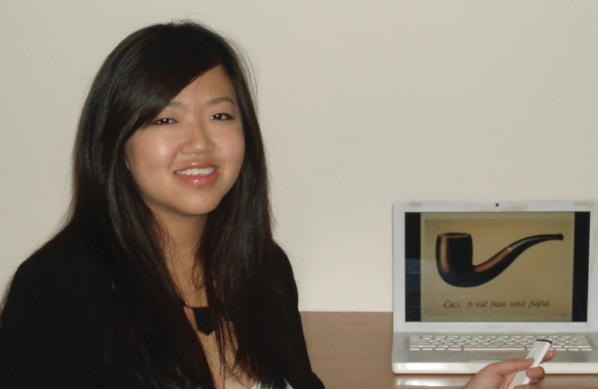Learning from a student’s presentation planning
Page contents:
Assignment analysis
A memorable introduction
Straightforward language
Vivid language
Print essay to presentation
Slides
Shuqiao Song’s assignment for her writing class on graphic narratives featured two major parts: first, she had to write a ten-
Assignment analysis
As she thought about her assignment and topic, Shuqiao realized that she had more than one purpose. Certainly she wanted to do well on the assignment and receive a good grade. But she also wanted to convince her classmates that Bechdel’s book was a complex and important one and that its power lay in the relationship of words and images. She also had to admit to at least one other purpose: it would be great to turn in a truly impressive performance. Her audience—
Back to top
A memorable introduction
Shuqiao Song found a six-
That was Alison Bechdel, author of Fun Home. In that clip, she conveniently introduces the topics of my presentation today: Words. Pictures. And the mystical way they work together.
Note that this introduction includes short sentences and fragments, special effects that act like drumbeats to get and hold the attention of an audience.
Back to top
Straightforward language
At the end of Shuqiao’s introduction, she decided to set forth the structure of her presentation in a very clear, straightforward, and simple way to help her audience follow what would come next:
So, to outline the rest of my presentation: first, I’ll show how text is insufficient—
Back to top
Vivid language
Shuqiao Song’s presentation includes crowd-
Now, to argue my second point, I’ll begin with an image. This is a René Magritte painting. The text means, “This is not a pipe.” Is this some surrealist Jedi mind trick? Not really. Now listen to the title of the painting to grasp Magritte’s point. The painting is called The Treason of Images. Here Magritte is showing us that “this is not a pipe” because it is an image of a pipe.
The intriguing image and vivid language (“surrealist Jedi mind trick”) help to keep the audience engaged.

Back to top
Print essay to presentation
To see the kinds of changes Shuqiao Song made as she turned her print essay into a presentation for a viewing and listening audience, compare this paragraph from her essay with the same information presented in her script.
Paragraph from Shuqiao Song’s essay
Finally, we can see how image and text function together. On the one hand, image and text support each other in that each highlights the subtleties of the other; but on the other hand, the more interesting interaction comes when there is some degree of distance between what is written and what is depicted. In Fun Home, there is no one-
Content from Shuqiao Song’s slide presentation
Finally, image and text can work together. They support each other: each highlights the subtleties of the other. But they are even more interesting when there’s a gap—
Still, Bechdel certainly pushes the boundaries that would allow us to bring closure between image and text. So what’s the take-
Notice that the paragraph and presentation cover the same ideas, but the presentation is written to be spoken and heard. To keep listeners focused and engaged, Shuqiao has revised the essay paragraph to include signpost language, repetition, simple sentences, and less formal English.
Back to top
Slides
For her presentation, “Residents of a DysFUNctional HOME: Text and Image,” Shuqiao Song developed a series of simple slides aimed at underscoring her points and keeping her audience focused on them. She began by introducing the work, showing the book cover on an otherwise black slide. Throughout the presentation, she used simple visuals—
Back to top
Student Writing: Critical analysis of graphic literature (Shuqiao Song)
Student Writing: Presentation (Shuqiao Song)